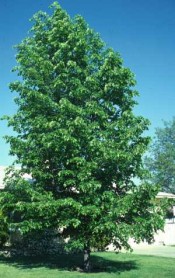Protecting Biologial Diversity
 Noting the serious threats posed to our state’s natural and agricultural resources by harmful invasive plants, insects and other organisms not native to our own state, Governor James E. McGreevey established a New Jersey Invasive Species Council charged to develop comprehensive measures to combat these dangerous invaders and protect the state’s biological diversity.
Noting the serious threats posed to our state’s natural and agricultural resources by harmful invasive plants, insects and other organisms not native to our own state, Governor James E. McGreevey established a New Jersey Invasive Species Council charged to develop comprehensive measures to combat these dangerous invaders and protect the state’s biological diversity. “Ensuring the protection of New Jersey’s rich biological diversity is an essential component of my smart growth initiatives. The health of our natural environment is essential for our quality of life and for our economic vitality,” said Governor McGreevey. “It is imperative that we take aggressive steps to address the threats posed by harmful invasive plants and insects on New Jersey’s natural and agricultural ecosystems.”
The Governor signed the Executive Order after accepting a new Department of Environmental Protection report that, for the first time, details the substantial problems posed by harmful invasive plant species, which crowd out native species and damage wetlands, uplands, lakes and rivers.
The Executive Order outlines the responsibilities of the new Invasive Species Council, co-chaired by DEP Commissioner Bradley M. Campbell and Department of Agriculture Secretary Charles M. Kuperus, which includes the development of a comprehensive New Jersey Invasive Species Management Plan to be submitted to the Governor by June 2005.
The Governor said that establishment of the Invasive Species Council will ensure that a comprehensive approach by all affected state agencies, as well as the horticultural, conservation and academic communities, is taken to address the serious economic and ecological threat.
Invasive species threaten New Jersey’s agricultural resources through lost production and marketability for agricultural products. Nationally, damage from invasive species cost $123 billion annually.
There are more than 1,000 nonindigenous plants in New Jersey that have been introduced from Europe and Asia. The report includes fact sheets on 29 nonindigenous plants documented to aggressively invade and establish native plant communities in New Jersey.
In addition to the DEP Commissioner and Agriculture Secretary, the Council will be comprised of the Commissioner of the Department of Transportation; the Chief Executive Officer and Secretary of the New Jersey Commerce and Economic Growth Commission; three representatives from conservation organizations; one representative from the agricultural sector; two representatives from the nursery and landscape sector; one representative of the New Jersey Agricultural Invasive Species Council; one representative from academia; and one or more members of the general public.
“It is important for us to recognize the problem posed by exotic invasive plants. This issue has been building as a quiet crisis for many years. The better we understand this problem, the better prepared we will be to seek viable solutions that will allow us to maintain our open spaces for the enjoyment of all our citizens and the preservation of our rich natural heritage,” said Campbell.
"Invasive plants and insects threaten the biological diversity and agricultural productivity of our land," said Agriculture Secretary Charles M. Kuperus. "By coordinating our efforts, we can more effectively help prevent the introduction of invasive species, and identify emerging problems and the resources to address them."
"We appreciate the opportunity to support the Governor's initiative to preserve and protect New Jersey's natural landscapes and ecosystems," said State Transportation Commissioner Jack Lettiere. "We look forward to working with the New Jersey Invasive Species Council to develop plans to ensure the future viability of our state's native vegetation and natural resources."
Most harmful invasive plant species were introduced in North America either accidentally or intentionally from other parts of the world. Because these tend to have few if any natural predators or parasites on this continent, they are aggressive competitors for space and nutrients.
They often form dense stands or thickets that crowd out native vegetation. Some invasives, such as the common reed, are actually native species that spread out of control as a result of land disturbances that altered the original ecological balance.
Harmful invasive species threaten plant biodiversity but also affect wildlife that depend on the displaced native species as a food source. Invasive species alter the structure, composition and function of natural ecosystems.
An earlier report, the Final Report of the New Jersey Comparative Risk Project, released in July identified invasive species, including plants, insects and other organisms, as one of the top four environmental problems facing the state.
That report also cited land-use change – the dramatic physical transformation of open, wooded, agricultural and wetland areas to suburban development – as the heart of many of New Jersey’s environmental problems. Habitat loss and fragmentation are leading to species loss and permanent destruction within several of the state’s ecosystems. Invasive species are more likely to proliferate on lands that have been disturbed.
New Jersey has taken some steps to eradicate invasive species. The departments of Environmental Protection and Agriculture have formed study groups, monitored invasive plants, developed agricultural invasive species management plans and have launched eradication and biological-control programs targeting selected insect pests such as the Asian longhorned beetle. If introduced into New Jersey’s forest ecosystem, this beetle, inadvertently brought from China, has the potential to damage all of the state’s 1.9 million acres of hardwood forests.
The hemlock woolly adelgid, an aphid-like insect native to China and Japan, poses a catastrophic risk to all 26,000 acres of hemlock forest in our state.
Among the plant species detailed in the new report is the Norway maple tree, which is still one of the most commonly planted street trees in New Jersey. Unlike most invasives that move into habitats disturbed by people, the Norway maple also invades undisturbed habitats and outcompetes other species. The Norway maple is highly effective in replacing diverse native hardwood forests because of its prolific seed production, tolerance to shade and aggressive competition.
Purple loosestrife is one of the most widespread invasive plants in New Jersey, invading wetlands and posing a direct threat to several state and federally endangered species. It occurs abundantly in wetlands throughout the state, except in the Pine Barrens where it occurs only rarely, in ditches and recently disturbed wetlands.
Some invasives are commercially sold, including Japanese barberry, offered as an ornamental shrub. Since it can tolerate low light, it invades deep into forests with closed tree canopies.
The most efficient way of controlling invasives is to prevent them from entering the state or eradicating them before they become entrenched and prolific.
The report, An Overview of Nonindigenous Plant Species in New Jersey, is available on the DEP’s Web site, here.
advertisement

Author: Press Release-Micah Rasmussen
Archives
Collingswood
A Southern Mansion
Light up the Night
Dining Alfresco
Sink or Swim
Throwing Shade
The Outdoors in Order
The Foundation
A New Spin on Swim
Gloucester Township
Wonderful Water
The Foundation: June, 2015
Community Connection: Moorestown
Things to Do
Cinnaminson
More...







